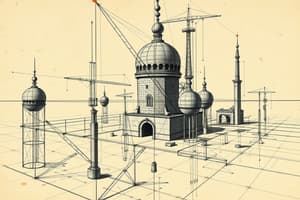Podcast
Questions and Answers
What shape does a circular hole become when distorted?
What shape does a circular hole become when distorted?
- Rectangle
- Ellipse (correct)
- Triangle
- Square
Which method is NOT used in the multiview drawing process?
Which method is NOT used in the multiview drawing process?
- Observer moves around the object
- Revolve the object
- Use the glass box concept
- Project from a fixed point (correct)
What is the purpose of a multiview drawing?
What is the purpose of a multiview drawing?
- To illustrate colors of the object
- To create a single perspective image
- To measure the depth only
- To show a set of images from different directions (correct)
What is the primary purpose of projection theory?
What is the primary purpose of projection theory?
What does the term 'depth' refer to in the context of multiview drawings?
What does the term 'depth' refer to in the context of multiview drawings?
Which of the following describes a line of sight (LOS)?
Which of the following describes a line of sight (LOS)?
In the glass box concept, which view is NOT represented?
In the glass box concept, which view is NOT represented?
What defines the boundary between two faces of an object?
What defines the boundary between two faces of an object?
What type of projection is primarily considered in this course?
What type of projection is primarily considered in this course?
Which of the following views is NOT included in the multiview drawing?
Which of the following views is NOT included in the multiview drawing?
What is a key characteristic of multiview drawing?
What is a key characteristic of multiview drawing?
Which of these views offers a virtual 3-D representation of an object?
Which of these views offers a virtual 3-D representation of an object?
What happens to a right angle in perspective drawing?
What happens to a right angle in perspective drawing?
What type of surface does not have edges?
What type of surface does not have edges?
What disadvantage is commonly associated with multiview drawing?
What disadvantage is commonly associated with multiview drawing?
Which statement best describes parallel projection?
Which statement best describes parallel projection?
Which of the following correctly describes the relationship between surfaces and their edges?
Which of the following correctly describes the relationship between surfaces and their edges?
What is a characteristic feature of multiview drawings?
What is a characteristic feature of multiview drawings?
What is a common advantage of pictorial drawings?
What is a common advantage of pictorial drawings?
In a glass box concept for multiview drawing, what is primarily projected?
In a glass box concept for multiview drawing, what is primarily projected?
Which of the following shapes has both surfaces and edges?
Which of the following shapes has both surfaces and edges?
What is the purpose of the glass box concept in projection techniques?
What is the purpose of the glass box concept in projection techniques?
When projecting an inclined plane, which type of projection technique is often utilized?
When projecting an inclined plane, which type of projection technique is often utilized?
In the context of curved surfaces, what can they do in relation to planes?
In the context of curved surfaces, what can they do in relation to planes?
What is a primary characteristic of projecting an oblique line?
What is a primary characteristic of projecting an oblique line?
What is a key consideration when transferring depth using direct measurement?
What is a key consideration when transferring depth using direct measurement?
What does the miter line technique involve?
What does the miter line technique involve?
Which of the following describes the projection of a curve line?
Which of the following describes the projection of a curve line?
What is a potential challenge when working with projections of objects having both curved and planar surfaces?
What is a potential challenge when working with projections of objects having both curved and planar surfaces?
What occurs in a multiview drawing when there is an intersection?
What occurs in a multiview drawing when there is an intersection?
Which statement accurately describes a tangential scenario in a multiview drawing?
Which statement accurately describes a tangential scenario in a multiview drawing?
In multiview drawing, what is a primary function of lines and areas?
In multiview drawing, what is a primary function of lines and areas?
Which type of plane is identified as having no edge in a multiview drawing?
Which type of plane is identified as having no edge in a multiview drawing?
When lines coincide in a multiview drawing, which type has the highest precedence?
When lines coincide in a multiview drawing, which type has the highest precedence?
What is the order of importance for coinciding lines from highest to lowest?
What is the order of importance for coinciding lines from highest to lowest?
What should you do first when interpreting the lines in a multiview drawing?
What should you do first when interpreting the lines in a multiview drawing?
Which line type represents an object feature that is hidden from view?
Which line type represents an object feature that is hidden from view?
Flashcards are hidden until you start studying
Study Notes
Orthographic Projection
- Purpose: To represent 3D objects in 2D formats like paper or screens.
- Concept: Based on line of sight (LOS) and plane of projection.
- LOS: An imaginary ray of light connecting an observer's eye to an object.
- Plane of projection: Imaginary flat plane where the image of the object is projected.
Types of Projection
- Parallel projection: LOS are parallel.
- Converging projection: LOS converge at a point.
- Orthographic projection*: A specific type of parallel projection where LOS is perpendicular to the plane of projection.
Multiview Drawing
- Definition: A set of related images depicting different views of an object from different directions.
- Methods:
- Revolving the object relative to the observer.
- The observer moves around the object (glass box concept).
Glass Box Concept
- Depicts different views of an object through six planes representing:
- Top, bottom, front, back, left, and right sides.
Object Features
- Edge: Represents the boundary between two surfaces.
- Surface limit: Represents the last visible part of a curved surface.
- Surface: An area bounded by edges or surface limits.
View Comparison
- Multiview drawing: Accurate representation of object's size and shape, requires training for visualization.
- Pictorial drawing: Easy to visualize, distorts shape and angles, circular holes become ellipses, right angles become obtuse angles.
- Perspective drawing: Realistic representation, difficult to create, size and shape distortion.
Line Convention
- Precedence of lines: Determines which lines take priority when lines coincide.
- Order of importance from highest to lowest: visible line, hidden line, center line, construction line.
- Hidden line drawing: Represents hidden edges and features of an object.
- Center line drawing: Represents axes of symmetry.
- Construction line: Used for auxiliary constructions in drawing.
Suggestion for Practicing
- Relate the object's features to the lines in a multiview drawing.
- Modify the object's features to observe the changes in the multiview drawing.
Types of Planes
- Normal plane: A plane perpendicular to the plane of projection.
- Inclined plane: A plane that is not perpendicular to the plane of projection.
- Curve surface: A surface that is not planar.
Studying That Suits You
Use AI to generate personalized quizzes and flashcards to suit your learning preferences.




